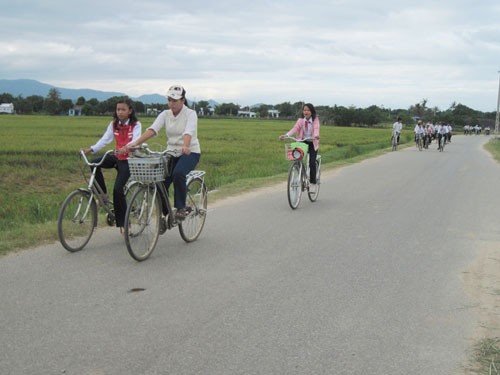(VOVworld) – Two years after the new rural development program was launched, Vietnam’s rural areas have changed day by day with improved living conditions, rural transport, and production. VOV’s Vinh Phong reviews the program’s achievements over the past two years.
 |
| Transport infrastructure contributes to improving rural areas in Ninh Phuoc. (Photo: baoninhthuan.com.vn) |
To date, 97% of communes in 63 provinces and cities have implemented programming on new rural development. Two thirds have adopted mater-plans and half have fulfilled projects on new rural development. In the provincial programming, the construction of infrastructure is considered a breakthrough in building new rural landscapes with 90% having at least one new infrastructure project. Some have 4 or 5. Although the quality of programming has been unqualified enough, rural people have become better aware of its necessity in new rural development. Nguyen Van Kiem, Vice Secretary of the Party Committee of Tay Hoa district in Phu Yen province, says that thanks to the programming, his locality has completed 12 of 19 criteria for new rural development. Kiem said ‘People play an important role in mobilizing resources to build new rural areas. People can easily understand responsibility from their village peers. Therefore we should gather them and tell them to look for consensus.’
Tang Minh Loc, Head of the Steering Committee of the National Target Program on new rural development, said that increasing production and raising local incomes is important. Vietnam now has more than 5,000 agricultural production models that have helped to increase efficiency 20%. The ‘bigger fields’ model in An Giang province has been copied by 40 other provinces. Ho Chi Minh City has promulgated policies to support high-tech zones while Thai Binh province has financed the purchase of ploughing machines and combine harvesters. Ha Tinh has offered farmers low-interest loans. These are positive measures that should be duplicated, according to Loc. Loc added ‘Before the program was implemented, communes were evaluated on 19 criteria. Only 200 communes met 10 of the criteria. None met 15 or more. Two years later, 1,000 communes have met 10 or more criteria. The 11 pilot communes, and 32 others have met 16 criteria and are aiming for 19 by 2015.’
The current hurdles are investment sources and limited awareness of leaders and beneficiaries about the movement. Despite the country’s economic hardships this year, the government has retained funding for the program of about 160 million USD over the past two years. Local authorities have found creative ways to get more investment capital. In Tuyen Quang province, if a commune builds a paved road, the province will put up half of the cost. After two years, Tuyen Quang has built more than 1,000 km of new roads. An Giang province is calling on private businesses to invest in bridges, roads, and schools. Loc said ‘Vietnam’s new rural development is a major, long-term program which has been experiencing great difficulties for two years mainly due to a lack of awareness of people and officials at the grass roots level. Many provinces still want to rely on state investment, so communications and training for officials should be enhanced.’
Vinh Phong